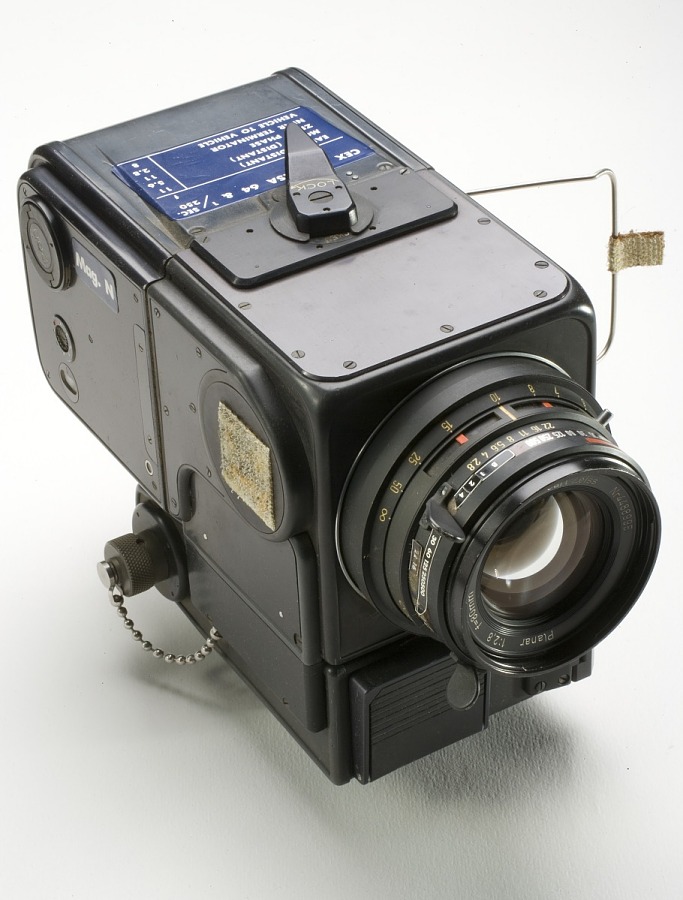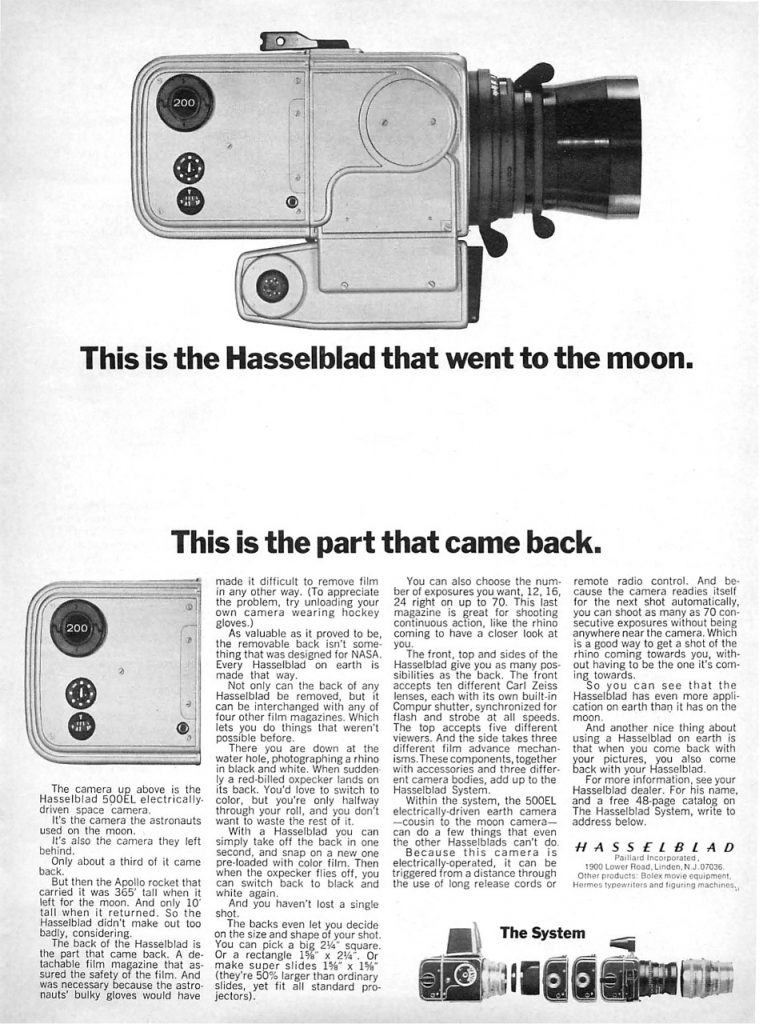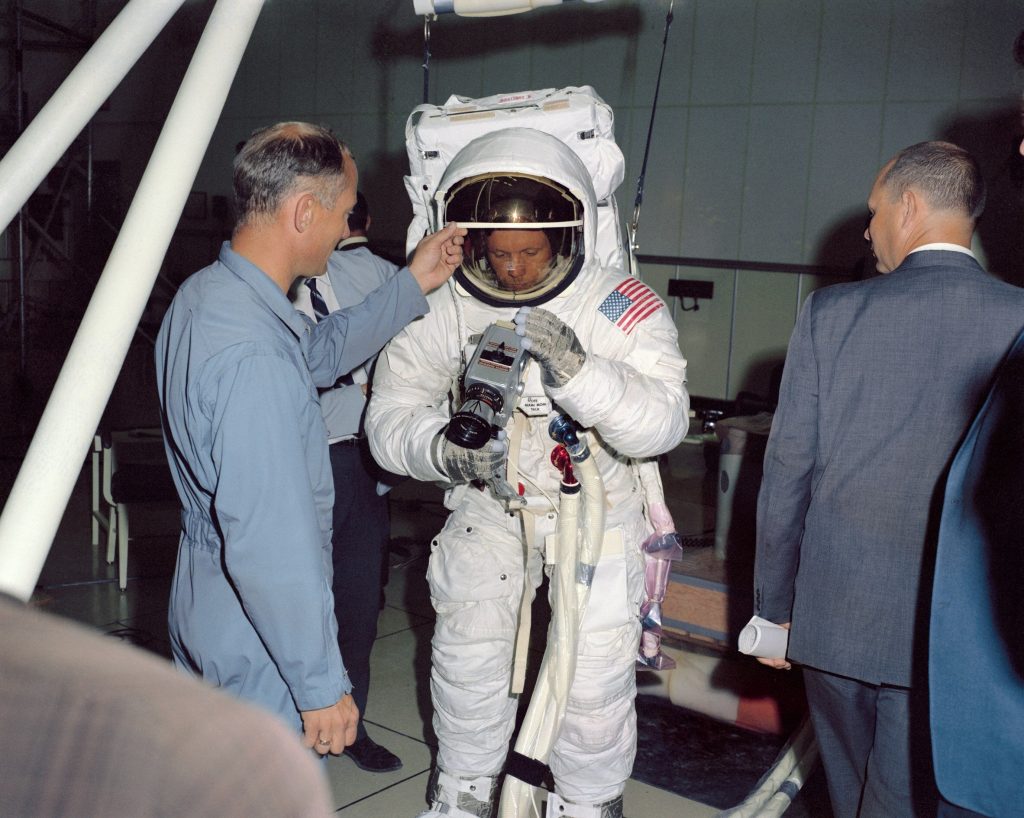July, 1969. It’s been seven months since ‘Earthrise’ was made. Three astronauts – Neil Armstrong, Buzz Aldrin, and Michael Collins – have landed on the moon and the former two have set foot on its surface. As the hatch of Lunar Module Eagle is closed, the astronauts take with them samples, video footage, photographs, and, of course, a seminal legacy. Left behind – the most valuable handheld cameras in our solar system.

A photograph of Armstrong’s footprint on the lunar surface, taken using a Hasselblad. (Image: Lunar and Planetary Institute)
We all know those famous words: ‘One small step for man; one giant leap for mankind’. And we all probably know of one or two images captured thereafter (and if you didn’t, then there’s an image above). But the story of how those images were made is often understated. In my previous article, I discussed the complications involved in simply taking a photograph in the runup to the Apollo missions. And, in my view, equally important are the physical cameras that documented the missions – especially Apollo 11. (By the way, for the rest of this article, when I say ‘cameras’, I mean the photographic, hand-held cameras used by the astronauts, rather than any video or satellite cameras). I mean, what cameras were they to produce such high-quality results? Can any camera be sent to space? Who decided which camera and why? And what about the visual elements of the images themselves? Honestly, the compositions are quite striking, almost suggesting a photographic eye. Was this intentional? Who took them? Above all, how were they taken? It’s a fascinating story that I hope to (somewhat) do justice in my collation of research. Apollo 11 was not only a remarkable achievement for space exploration, rocket science, and humanity, but also for photography: let’s celebrate. This article is unapologetically long because, again, it’s more of a story. So, let’s begin.
The first space camera

Photograph of North Africa from space, taken by John Glenn in the Friendship 7 spacecraft during NASA’s Project Mercury MA-6 mission. (Image: The John Glenn Archives – Ohio State University)
This picture is to the best of my knowledge the first hand-held camera picture ever taken from space. I took it during the first orbit of my Friendship 7 flight on February 20, 1962, during the early stages of our first effort to accomplish manned orbital flight. NASA knew that pictures from orbit were an important part of showing the public the beauty of space, as well as the importance of exploring it.
– John Glenn, the first American to orbit the Earth, in an interview with TIME Magazine
This photograph was not taken using the same camera used for Apollo 11. And, despite the credit Glenn deserves here, this was one of the few usable and ‘good’ photographs taken on this mission (MA-6). In fact, NASA was quite disappointed with the results. Described as a ‘tourist camera’ by Hasselblad product manager Ove Bengtsson, the camera used for this mission was a Minolta Hi-Matic – a 35mm rangefinder. It was chosen by Glenn himself, who waltzed into a Cocoa Beach drugstore to buy it after a haircut; he was doing errands. To be fair, NASA didn’t instruct Glenn otherwise, and ultimately they gave the green light for the camera to be sent to space. As far as the camera’s benefits went, it had automatic exposure settings, so Glenn would not need to worry about adjusting the aperture. It was barely changed from its original design, only adding a few shoddy modifications to somewhat improve the hand-held functionality. Most noticeable is the orientation of the camera: due to the bulkiness of astronaut gloves, engineers flipped the camera upside-down to attach a pistol grip and special buttons that controlled the shutter release and film advance. For a supposedly small 35mm camera, it was awkward and cumbersome to use.
It was not used for any Apollo missions.

John Glenn’s camera held in front of Friendship 7. (Image: Eric Long, National Air and Space Museum)
Remembering Walter Schirra
NASA was evidently out of their depth. They had trouble figuring out how an astronaut could physically use a camera in space – so much so that a camera wasn’t brought for the first Gemini mission. Not many cameras were simple enough to operate on Earth to make them easy enough to use in microgravity; at least, not until prospective astronaut and photography enthusiast Walter Schirra was invited to NASA’s photography discussions in 1962.
Following the photographic shortcomings of the Mercury MA-6 mission, NASA assembled a team of engineers and astronauts to discuss the photography of their upcoming Apollo missions. In that team was Schirra, who had his own Hasselblad 500C with a Planar f/2.8, 80mm lens. Impressed by the quality of the camera and its results, Schirra proposed that NASA use a Hasselblad to document future space missions. At the pricier end of the market, and designed primarily for studio use, the camera seemed an equally unusual choice as the original Minolta. Nevertheless, NASA decided to work with him to ‘astronaut-proof’ his private camera – more thoroughly and diligently than they had previously. They too trusted the brand for inventor and founder Victor Hasselblad and his contribution to Swedish reconnaissance photography: during WWII he adapted and upgraded a salvaged German camera to help Sweden in the war effort. Still, it was ultimately Schirra who precipitated a relationship between NASA and Hasselblad: Schirra’s contribution would ultimately become the standard for still photography on subsequent American space missions, including Apollo 11.
Making the Apollo camera
As a medium format (70mm) camera, Schirra’s 500C was objectively better than the previous 35mm rangefinder due to its superior photographic resolution, which was optimum for scientific analysis back on Earth. The 500C was also more practical than its predecessor in so far that it had detachable film magazines (also known as ‘backs’), which could easily be swapped out (mid-roll) depending on whether black-and-white or colour film was required. The overall modularity of Hasselblad cameras also meant that ‘astronaut-proofing’ them was less of a Hassel (sorry).
To ensure the success of the Apollo missions, NASA was cautious about weight onboard, as it would impact fuel efficiency and supply. Hence, after buying several 500Cs, a rigorous weight-loss programme ensued in preparation for the Mercury MA-8 mission in 1962: this included the removal of its leather covering, reflex mirror, auxiliary shutter, and viewfinder. Yes – the viewfinder too. Not only was a viewfinder heavy, but it was also awkward to use through the visor of a spacesuit. Instead, astronauts – including those on Apollo 11 – were trained to use distance scales on the lens to focus (pairing a higher aperture with a wide-angle lens to create a wider zone of focus) and learnt from basic guides to compose their shots. In fact, if you want similar training, then Hasselblad and NASA produced this manual detailing not only the basics of space photography but also more general concepts such as lighting, composition, and operation of the 500EL/M.

Aldrin practising using the Hasselblad EDC during Extravehicular Activity training for Apollo 11 – taken in April, 1962. (Image: NASA)
I digress. A redesigned film back permitted 70 exposures instead of the usual 12 for 6×6 medium format cameras; and a matte black outer paint-job reduced reflections in the window of the Mercury orbiter.

By the end of Project Mercury, Hasselblad 500Cs such as this had become the standard for still photography on American space missions. (Image: National Air and Space Museum)
It was not until exposures from the 500Cs were developed from the MA-8 mission that NASA, impressed with Schirra’s results, formally commenced a partnership with Hasselblad for future space missions. In turn, Hasselblad built upon and refined NASA’s initial modifications: they made them even more suitable for space use and as lightweight as physically and technically possible, whilst still maintaining the high photographic and construction quality.
And this they did. By 1969, Hasselblad had begun using their 500EL model as the base for their space cameras. This model featured a motor drive mechanism in the baseplate of the camera: this automatically pulled the exposed film onto an uptake spool and prepared the shutter for the next exposure. Whilst the motor added weight and electronic complication, it also drastically minimised the chances of the film breaking inside the back, which would render the stock useless. It also reduced the possibility of light leaks. A much sleeker solution than that weird pistol grip.
Hasselblad had also prepared an additional experiment – a further repurposing of the 500EL known as the Electric Data Camera (EDC). It was this camera which would document the historic Apollo 11 as we remember it. Actually, it was the only camera, for it was the only one brought on the Apollo 11 mission which was designed for lunar surface documentation. And it had never been tested in space beforehand.
It was for this purpose that the EDC was specially outfitted in a silver paint-job – to maintain uniform internal temperatures despite the temperature extremes on the moon. It had to work perfectly between over 120° C in the sun and -65° C in the shade, otherwise the film – and, with it, recorded history – would disintegrate. The two magazines carried alongside the EDC also had silver finishes for this reason. The lubricants used in the internal mechanism had been removed to avoid boiling in the vacuum of space; the special replacement appears to have been kept classified.
There were further modification differences between the 500EL and the EDC. One such was that the latter included a Réseau plate – a custom-made plate of glass placed near the film plane and engraved with gridded reference markers. This meant that, when the film was exposed, each photograph was imprinted with cross marks which could be used to establish heights and distances within the photograph as well as correct any distortions. This was especially important as the Moon lacks distinguishable landmarks and points of reference. This photo plate was also coated in a thin layer of silver to prevent sparks between the film and the plate caused by the accumulation of static electricity.
When film is wound in a camera, static electricity is generated on the film surface. Normally, this electricity is dispersed by the metal rims and rollers that guide the film, and by the humidity of the air. In a camera fitted with a Reseau plate, however, the film is guided by the raised edges of the plate. As glass is a non-conductor, the electric charge that builds up at the glass surface can become so heavy that sparks can occur between plate and film – especially if the camera is used in a very dry environment or in vacuum. Sparks cause unpleasant patterns to appear on the film and can be a hazard if the camera is used in an atmosphere of pure oxygen.
Another modification was the increased sizes of the shutter button and other controls for ease of operation whilst wearing thick spacesuit gloves. It’s also important to mention that NASA fashioned the EDC to a rig on the spacesuit, not only to uniformly frame all shots from chest-level but also to make handling easier and less risky (Armstrong accidentally dropped the most important film back on the lunar ground).

Taken during the Apollo 12 mission, this photograph of astronaut Alan L. Bean shows an EDC (identical to that used for Apollo 11) attached to his spacesuit as well as the grid marks caused by the Reseau plate in a second EDC operated by Charles Conrad Jr. (Image: NASA)
The internet appears quite confused on this, but according to an official NASA report from 1970, three Hasselblad models, consisting of four cameras, were brought for Apollo 11.
The camera equipment carried by Apollo 11 consisted of one 70-mm Hasselblad electric camera, two Hasselblad 70-mm lunar surface superwide-angle cameras, one Hasselblad EL data camera, two 16-mm Maurer data acquisition cameras, and one 35-mm lunar surface closeup stereoscopic camera.
Because the internet is confused, I also got quite confused researching details such as which camera paired with which lens. I mean, even NASA doesn’t seem too sure depending on which report you read. I imagine this confusion deliberately arises in the interests of secrecy. Nevertheless, I will do my best to reconcile and explain.
So, it appears that three cameras brought on the Apollo 11 mission were based on the conventional 500EL model, which was tried and tested on the Apollo 8, 9 and 10 flights. One of these cameras, known as the Hasselblad Electric Camera, featured a motor drive and was equipped with two lenses: a Planar f/2.8, 80mm lens and a Sonnar f/5.6, 250mm telephoto lens. This camera stayed with Michael Collins on the Command Module. Two cameras, named eloquently the Hasselblad Lunar Surface Superwide-Angle Cameras, were also slight variations of the 500EL, but had a 38mm lens (aperture not specified) and had no motor drive. These cameras were designed to be used in the Eagle. (According to this NASA article, an additional Planar f/2.8, 80mm lens was available for this camera, however this detail is absent from their own 1970 lunar photography report). Alongside them was the camera that did leave the Eagle, the camera which was most different from the conventional 500EL, the EDC. This was fitted with a new, specially designed f/5.6, 60mm Biogon lens by Carl Zeiss, which was rigorously tested and eventually made commercially available due to its high-quality, low-distortion glass.
Using the Apollo camera
According to the 1970 report, here were NASA’s photographic objectives for Apollo 11:
(1) to photograph “targets of opportunity,” i.e., scientifically interesting sites, and potential Apollo landing sites as time and circumstances permitted; (2) to obtain photographs of the lunar module and lunar surface activities after LM landing; (3) to obtain vertical and oblique stereo strips of nearside and farside regions of scientific interest; (4) to record mission operational activities; and (5) to obtain documentation for subsequent landing crew training purposes.
As part of the astronauts’ training, the photographs were metered for the brightly sunlit lunar surface and the white spacesuits. Thus, the exposure times were very short – too short to detect the light of stars in the sky (no, really, the moon landing wasn’t fake).
The redesigned film backs had been upgraded from their 1962 versions, allowing for 160 colour exposures or 200 black-and-white exposures per loading (using rolls of specially produced Kodak Ektachrome). This plenitude resulted in a total of 1,408 usable exposures from the Apollo 11 Hasselblads within 21 and a half hours – 857 on black-and-white film and 551 on colour film.
The world was eagerly waiting to see. Requests for the first release of photographs were unmeasurable, according to Ann Bownds of the Still Photo Press Library who described them as ‘stacked to the ceiling’. However, an official NASA document describes how the space agency’s Office of Public Affairs, scrambling to satisfy international media with photographs of the historic moon landing, discovered an embarrassing oversight: where was Armstrong, the first man to walk on the moon, in the photographs? ‘They started looking for the best shot of Armstrong,’ according to the transcript. ‘Soon they were looking for any shot of Armstrong.’ As Aldrin, who was already busy setting up lunar experiments, believed that Armstrong was the better photographer, only a single photo was taken of Armstrong.
The photographs taken in the film back coded S were especially valuable. They were the first to be taken of the moon landing, using the EDC. As magazine S contained what were likely the most important photographs in the world at the time, NASA refused to let the frames go through the first batch of the decontamination process, despite pressure from the press. If the process failed, they didn’t want that particular roll to also fail. John Holland Jr., head of the Technical Laboratory Branch at NASA, relates that, ironically, ‘it was in the handling of that precious magazine S film that the photographic industry achieved the dubious distinction of having the first man to touch lunar soil — with his bare hands, that is’. As photo lab technician Terry Slezak reached into the sealed plastic bag for the exposed Hasselblad film back, he was contaminated by lunar dust. To further the irony, inside the bag was a note from Armstrong explaining that this was a very important film back – the one exposed on the lunar surface – and that it had been dropped by him, hence gathering moondust.
A full archive of photos from the Apollo missions taken using Hasselblad cameras can be found here.
A graveyard for a camera

A magazine cut-out about the Hasselblad EDC. (Image: BelieveInFilm)
And as for the cameras? They were never supposed to return to Earth. The astronauts were instructed to leave the Eagle 500ELs and the EDC (with their accompanying lenses) on the moon to meet strict weight margins that would ensure successful lift-off. Of the cameras, only the magazines would make their way back to Earth. Instead, 25kg of moon rock would make the return trip. Moon rock, it turns out, is more valuable than cameras.
In fact, this was the order given for all of the Apollo missions. And so that’s where twelve Hasselblads remain today – in stasis, at the six Apollo landing sites. Disposable cameras for permanent moments.
This article was written using a range of sources. Here are a few sources used/further information:
‘Photographing Apollo 11’, by ASC
‘Hasselblad in Space’, by Hasselblad
‘APOLLO 11 LUNAR PHOTOGRAPHY’, by NASA
‘Apollo 11 Hasselblad Cameras’, by Phill Parker (Apollo Lunar Surface Journal)
‘Hasselblad, Kodak & Apollo 11’, by grainydays
(Featured image: NASA. All images credited to NASA originate from NASA’s Image and Video Library and follow NASA’s Media Usage Guidelines.)


